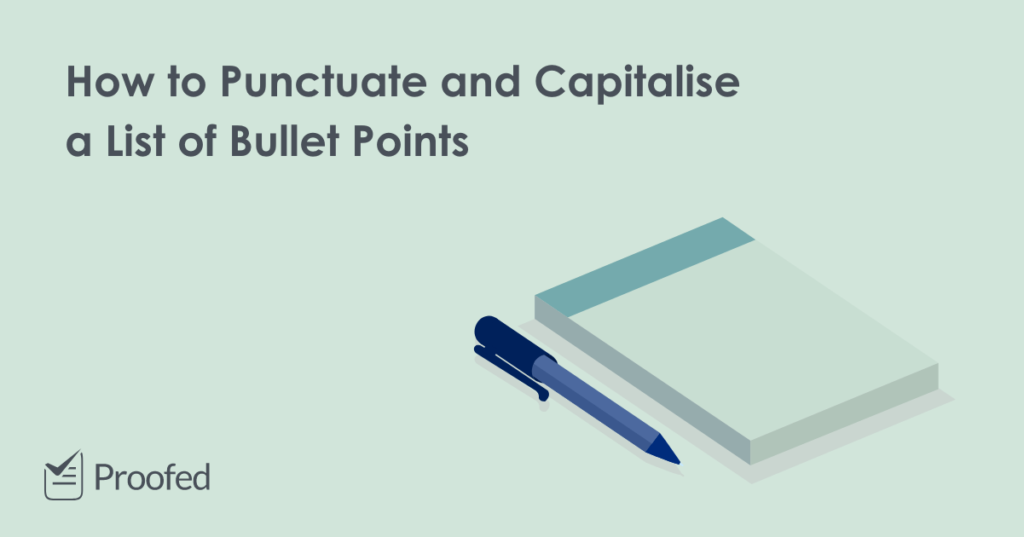Everyone loves a vertical list. They’re easy to read. They look good. Why wouldn’t you want to add a list to your work? The tricky thing is punctuation. Do you need a colon to introduce a list? Should each point start with a capital letter and end with a full stop? So many choices to make!
To help, we’ve prepared a guide to punctuating and capitalising bullet points.
Introducing a List: Do You Need a Colon?
When a vertical list follows a full sentence, introduce it with a colon.
There are two main methods available:
-
- Qualitative interviews with key staff members.
- Quantitative surveys involving all stakeholders.
You can also use a colon after a partial sentence.
Available methods include:
-
- Qualitative interviews with key staff members.
- Quantitative surveys involving all stakeholders.
However, you can omit the colon when a list follows a partial sentence.
Available methods include
-
- Qualitative interviews with key staff members.
- Quantitative surveys involving all stakeholders.
This is ultimately a matter of stylistic preference. But if you are using a style guide, you may want to check it for guidance on which style to use.
Punctuating Bullet Points: Do You Need Full Stops?
We’re often asked whether you need a full stop at the end of each entry in a list. And, as a guideline, we’d suggest punctuating bullet points as follows:
- When listing full sentences, use a full stop for each entry (like here).
- For lists with longer sentence fragments, full stops are optional.
- For a mix of fragments and full sentences, use a full stop at the end of each entry (just as you would for a list of full sentences).
- When listing single words or short phrases, there’s no need for a full stop.
However, this again comes down to preference and your chosen style guide. The key thing is applying a clear and consistent punctuation style to all lists.
Semicolons and Commas in Lists
Although a little old-fashioned, some people like to use semicolons or commas in lists. This is usually done when each list entry finishes an introductory phrase, as shown below:
Over the weekend, I have
Find this useful?
Subscribe to our newsletter and get writing tips from our editors straight to your inbox.
-
- Taken the dog for a walk by the river;
- Attended a dance class with Yvonne; and
- Made a spaghetti carbonara.
The idea is that the list reads like a single sentence, with semicolons separating each point, a conjunction just before the final entry, and a full stop at the end.
We could also write this list with commas instead of semicolons.
Over the weekend, I have
-
- Taken the dog for a walk by the river,
- Attended a dance class with Yvonne, and
- Made a spaghetti carbonara.
These are perfectly acceptable, and some style guides suggest writing lists like this. However, most people now leave out the extra punctuation.
Capitalising Bullet Points
Finally, should you capitalise the first letter of each entry in a vertical list? And if so, when? This is another case where there are no hard rules! If you have a list of full sentences – or a list with a mix of full sentences and fragments – we suggest capitalising the first letter in each item.
Activities for this weekend:
-
- Howl at the moon on the strike of midnight.
- Take grandmother for lunch.
- Dance on the graves of my enemies.
- Introspective sitting and drinking.
For lists of fragments, short phrases, or words, capitalisation is optional:
My favourite fruits include:
- oranges
- apples
- bananas
- dragon fruit
My favourite fruits include:
- Oranges
- Apples
- Bananas
- Dragon fruit
As with the other optional punctuation above, though, make sure to use a consistent capitalisation style throughout your writing. And if you’d like any more help with the punctuation and capitalisation of lists in a document, don’t forget we have proofreaders available 24/7!
